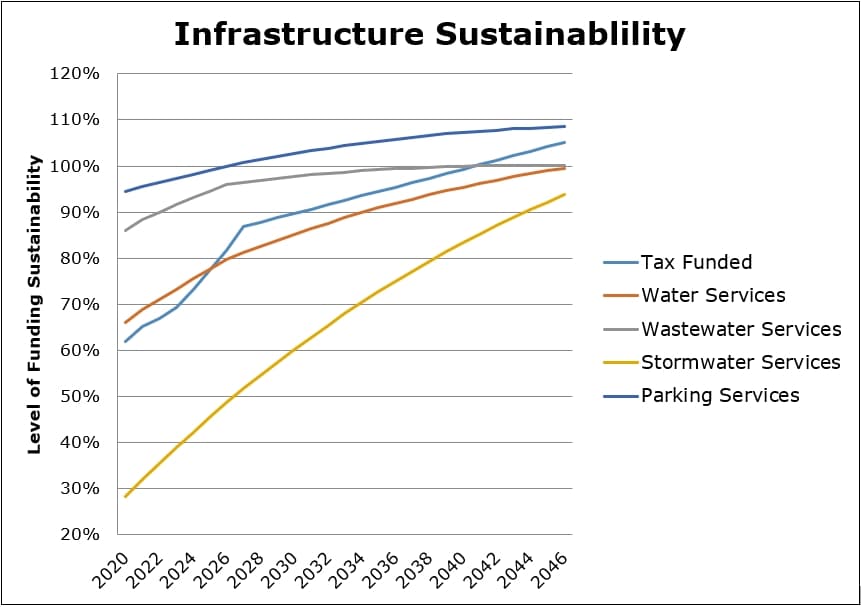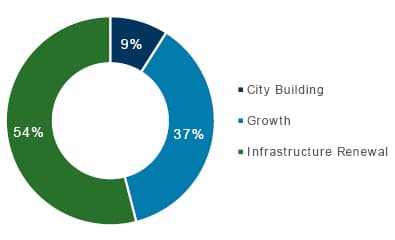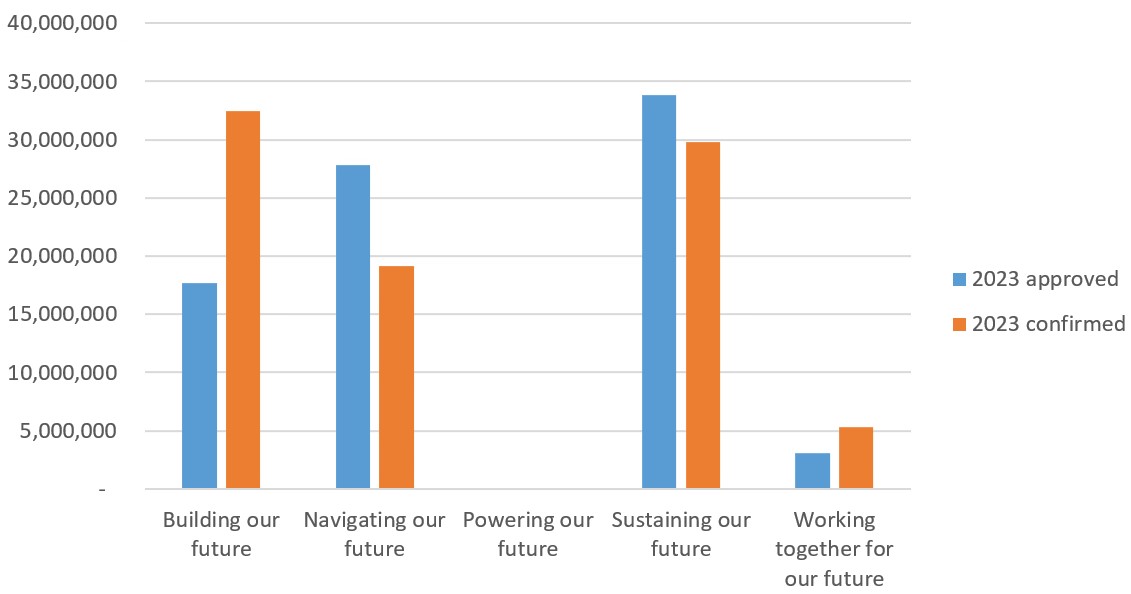On this page
The City of Guelph’s Infrastructure Renewal Strategy has one main goal, ensuring the continued operation of all active City assets at a level to provide expected service and ensure the safety and well-being of citizens and staff.
Corporate Asset Management Plan
The City manages an inventory of more than $4.39 billion in assets, including roads, bridges, facilities, pipes, structures, vehicles, and equipment. The age, condition and criticality of each asset determines when and how it must be maintained and ultimately replaced. The City’s Corporate Asset Management Plan (CAMP) sets out the practices and policies that guide this work. The City’s asset management practices have been evolving since 2016, now achieving a “core” rating. Continued focus on improving data collection, implementing support systems and development of Asset Management teams to achieve overall maturity in our Asset Management plans.
The CAMP also establishes the estimated annual cost of maintenance and capital renewal. Currently, the City has a resource gap between the sustainable funding required and the amount available each year from the City’s operating budgets as transfers to capital reserve funds.
Capital Infrastructure Renewal Strategy
The target capital sustainable funding levels identified in the CAMP are based on current replacement cost of all assets the age and condition of each. The sustainable funding targets will continue to be refined as the City’s practices mature, the most recent update saw significant changes in targets for some groups of assets, based on improved inventories, condition and useful life data. Through continued exercises to better understand the current state of the City’s assets, a more consistent estimate will evolve.
With the knowledge that the target is continuously being refined through the above work, the City has taken a long-term approach to reaching capital sustainability in each of the service groups identified the Infrastructure Sustainability chart below.
The City looks at the water, wastewater, stormwater and parking services sustainability levels individually due to their segregated user-rate funding models. The tax-supported businesses are then grouped in the tax category and include roads, bridges, community centres, transit fleet and facilities, City Hall and emergency service facilities and vehicles.

Level of funding sustainability
| Year | Tax Funded | Water Services | Wastewater Services | Stormwater Services | Parking Services |
|---|---|---|---|---|---|
| 2022 | 67% | 71.1% | 90% | 35.5% | 96% |
| 2023 | 69.4% | 73.3% | 91.6% | 38.9% | 97% |
| 2024 | 73.2% | 75.5% | 93.1% | 42.3% | 98% |
| 2025 | 77.4% | 77.6% | 94.6% | 45.5% | 99% |
| 2026 | 81.7% | 79.8% | 96.1% | 48.6% | 100% |
| 2027 | 86.9% | 81.2% | 96.5% | 51.7% | 101% |
| 2028 | 87.8% | 82.6% | 97% | 54.6% | 101% |
| 2029 | 88.1% | 83.9% | 97.4% | 57.5% | 102% |
| 2030 | 89.7% | 85.2% | 97.7% | 60.2% | 103% |
| 2031 | 90.6% | 86.5% | 98.1% | 62.9% | 103% |
| 2032 | 91.6% | 87.6% | 98.4% | 65.5% | 104% |
| 2033 | 92.5% | 88.8% | 98.7% | 68% | 104% |
| 2034 | 93.5% | 89.9% | 98.9% | 70.4% | 105% |
| 2035 | 94.5% | 90.9% | 99.2% | 72.8% | 105% |
| 2036 | 95.4% | 91.9% | 99.4% | 75% | 106% |
| 2037 | 96.4% | 92.8 | %99.6% | 77.2% | 106% |
| 2038 | 97.4% | 93.7% | 99.7% | 79.3% | 107% |
| 2039 | 98.3% | 94.6% | 99.9% | 81.4% | 107% |
| 2040 | 99.3% | 95.4% | 100% | 83.3% | 107% |
| 2041 | 100.3% | 96.2% | 100.1% | 85.2% | 108% |
| 2042 | 101.2% | 96.9% | 100.1% | 87.1% | 108% |
| 2043 | 102.2% | 97.6% | 100.2% | 88.8% | 108% |
| 2044 | 103.2% | 98.3% | 100.2% | 90.5% | 108% |
| 2045 | 104.1% | 98.9% | 100.2% | 92.2% | 108% |
| 2046 | 105.1% | 99.5% | 100.2% | 93.8% | 108% |
Sources of funding
Great progress has been made since 2015 when the need for additional capital funding was first addressed. The current tax supported infrastructure renewal strategy was introduced in 2017 to move the City towards sustainable funding over a planned 10-year implementation phase. Through the first five years of the strategy, the increase in annual tax funding directed to infrastructure renewal was $10.0 million with a cumulative amount of $29.1 million. For rate supported assets an additional $9.7 million is being transferred annually to capital reserve funds, and over the past five years this has totalled $35.5 million.
Tax and rate funding is not the only source of funding directed to achieving sustainable infrastructure funding, both Dedicated Gas Tax Funds for Public Transportation Program (provincial gas tax) and the recently renamed Canada Community-Building Fund (federal gas tax) funds are used primarily to support infrastructure renewal and are included when measuring progress towards sustainability. This funding strategy also includes investment income earned on the reserve funds, and dividends from both Guelph Municipal Holdings Inc. and Guelph Junction Railway. The City is actively applying to other grants as well to help fund these requirements, most recently to the Disaster Mitigation and Adaptation Fund for which the City has applied for $35.7 million in funding for FM Woods Water Treatment Plant Upgrades, Wastewater Treatment Facility Upgrades, and Stormwater Management Network Priority Upgrades.
Capital Program Resourcing Strategy
While attaining sustainable long-term funding will ensure that the monetary resources are available to purchase new vehicles, hire contractors to replace facilities and underground infrastructure, all of these projects require people resources within the City to ensure the projects are planned, executed and completed appropriately. Through review of the previous five years of capital activity it was determined that a shortage of people resources was preventing the City to execute the capital budgets that were being approved at the expected pace we need to be moving. In June, staff presented Council with the Capital Program Resourcing Strategy to address this growing issue, by investing in the necessary people resources to enable the delivery of expanded capital programs. A budget request (BR921) is proposed to Council which recommends adding 10 positions in 2022 and seven positions in 2023. These positions will provide additional direct project management capacity as well as internal support for accounts payable, communications and project design functions.
Accumulated infrastructure backlog
The CAMP identifies a portion of assets which have reached their end of useful life from either age or condition bases and are still in use and delivering service. The current estimate of the total replacement value of assets in this category is $289 million. While these assets are at the end of life, they are still providing service and there is minimal risk from continuing to use them in their current condition. The most significant impact of continuing to keep assets in this category is the high cost of maintenance and upkeep and the reduced level of service. The assets in this category are the City’s first priority each year when assessing which projects to put into the next year’s budget, and as they are renewed or replaced the assets move from this category to very good condition category. However, other assets continue to fall into the backlog category while current levels of funding and project execution are below sustainable levels.
One-time funding programs such Public Transit Infrastructure Funding (2017) can help reduce the backlog, but only temporarily. Without sustainable funding the amount of assets falling into this category will continue to outpace the City’s ability to renew and replace assets already in the backlog. The availability of one-time funding for capital renewal projects still requires the people resources to carry out and support the delivery of the projects.
Next five years
As capital-related staff are on-boarded and capacity to deliver projects is expanded, the level of capital spending is forecasted to double by the end of this strategy implementation. However, it’s going to take five to seven years to see the full result and based on this timing and current levels of annual funding, the pace of increase to both the tax supported and rate supported capital transfers is being slowed for the next two years. This change in the infrastructure sustainability funding plan will mean an extension from ten to eleven years as well. The net increase in annual funding will be the same, it’s just the period of time that is being extended by one year.
In that time frame, additional work will be completed to gather more data through the CAMP, continued implementation of Corporate Maintenance Management System and continuous improvement work through the City’s Project Management Office. All of this work will enhance our understanding of the state of assets as well as the future requirements for both monetary and human resources to ensure their continued ability to deliver service.
| Funding Source | 2021 Capital Reserve Fund Transfer | 2022 Increase | 2023 Increase | 2024 Increase | 2025 Increase | 2026 Increase |
|---|---|---|---|---|---|---|
| Tax | $30,896,000 | $2,674,300 | $2,558,000 | $3,993,400 | $4,156,200 | $4,134,000 |
| Parking | $2,840,500 | $524,000 | $111,000 | $107,000 | $66,000 | $88,000 |
| Stormwater | $6,346,000 | $800,000 | $800,000 | $800,000 | $800,000 | $800,000 |
| Wastewater | $14,862,800 | $303,600 | $312,600 | $320,300 | $497,900 | $634,000 |
| Water | $14,632,300 | $489,800 | $498,600 | $499,800 | $590,300 | $730,000 |
| Total | $69,577,600 | $4,791,700 | $4,169,200 | $5,720,500 | $6,110,400 | $6,386,000 |
2022 to 2031 Capital Budget and Forecast Infrastructure Renewal Projects
The capital budget and forecast is primarily focused on infrastructure renewal projects given the significant and growing backlog identified in the Asset Management Plan update. Approximately $1.1 billion, or 54 per cent of capital spending is identified within the 10 years that address aging infrastructure.
2022 to 2031 Capital Plan by type

Notable projects include:
- Operations Campus—replacement of 170 Watson Road, 45 and 50 Municipal Street, and Riverside Park facilities.
- Road reconstruction—total road reconstructions including replacement wastewater collection system, water supply system and reconstruction of road surfaces: York Road—Stevenson to Victoria; Paisley Road. Feedermain Phase 3—Ryde Road to just before Fischer Drive; PN0847 Manitoba Street— Ontario to Huron Street, and Metcalfe—Eramosa to Terry.
- Bridge renewal—bridge replacement as part of the full reconstruction of Speedvale Avenue—Woolwich to Metcalfe. Structure replacement on Imperial Road North, and repairs on Edinburgh Road structure as recommended in the bi-annual Ontario Structure Inspection Manual (OSIM) inspections report.
- Water transmission—Implementation of a North West Industrial Area Cast Iron Watermain Replacement Program to address watermain material types subject to failure and associated service disruptions to area industrial customers—including the replacement of cast-iron watermain on Speedvale Avenue West from Edinburgh Road to Silvercreek Parkway North in 2021.
- Wastewater Services—digester structural repairs and gas proofing to maximize life expectancy.
- Stormwater Services—Stormwater Management (SWM) facility rehabilitation (ponds).
2023 confirmed budget
Capital prioritization
In accordance with the criteria outlined in Report 2022-118 Inflationary Financial Impact Strategy, staff completed a holistic review of the approved 2023 capital budget. This capital prioritization exercise resulted in an increase of $4.4 million in infrastructure renewal projects moving forward in 2023 beyond what was previously approved for the 2023 capital budget. The majority of the changes were within “Building our future” and “Navigating our future” pillars which can be seen in Figure 1 – 2023 Infrastructure renewal budget by strategic plan pillar. Individual project adjustments can be found in the budget dashboard.
Figure 1 – 2023 infrastructure renewal budget by strategic plan pillar

| Strategic plan pillar | 2023 approved | 2023 confirmed |
|---|---|---|
| Building our future | 17,682,000 | 32,479,000 |
| Navigating our future | 27,834,200 | 19,135,200 |
| Powering our future | n/a | n/a |
| Sustaining our future | 33,790,300 | 29,820,700 |
| Working together for our future | 3,045,500 | 5,324,400 |
